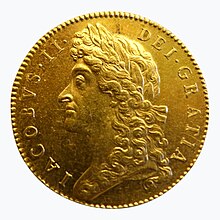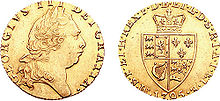
Back جنيه (عملة بريطانية) Arabic Гінея Byelorussian Гвинея (монета) Bulgarian Guinea (moneda) Catalan Guinea (mince) Czech Guinea (mønt) Danish Guinee German Γκινέα Greek Gineo Esperanto Guinea (moneda) Spanish

The guinea (/ˈɡɪniː/; commonly abbreviated gn., or gns. in plural)[1] was a coin, minted in Great Britain between 1663 and 1814, that contained approximately one-quarter of an ounce of gold.[2] The name came from the Guinea region in West Africa, from where much of the gold used to make the coins was sourced.[3] It was the first English machine-struck gold coin, originally representing a value of 20 shillings in sterling specie, equal to one pound,[2] but rises in the price of gold relative to silver caused the value of the guinea to increase, at times to as high as thirty shillings. From 1717 to 1816, its value was officially fixed at twenty-one shillings.[4]
In the Great Recoinage of 1816, the guinea was demonetised and the word "guinea" became a colloquial or specialised term. Although the coin itself no longer circulated, the term guinea survived as a unit of account in some fields. Notable usages included professional fees (medical, legal, etc.), which were often invoiced in guineas, and horse racing and greyhound racing,[2] and the sale of rams. In each case a guinea meant an amount of one pound and one shilling (21 shillings, £1.05 in decimal notation).[a]

- ^ The Oxford Dictionary of Abbreviations. Oxford University Press. 1998. ISBN 0-1928-0003-5.
- ^ a b c Roberts, Chris (2006). Heavy Words Lightly Thrown: The Reason Behind Rhyme. Thorndike Press. ISBN 0-7862-8517-6.
- ^ Chambers, Robert, Domestic Annals of Scotland. Edinburgh: W & R Chambers, 1885. p. 259.
- ^ Chisholm, Hugh, ed. (1911). . Encyclopædia Britannica. Vol. 12 (11th ed.). Cambridge University Press. p. 697.
Cite error: There are <ref group=lower-alpha> tags or {{efn}} templates on this page, but the references will not show without a {{reflist|group=lower-alpha}} template or {{notelist}} template (see the help page).